Help For Out-of-Pocket Medical Costs | FixedIndemnityInsurance.com
Cash for common, covered medical services
Hospital services
Surgical services
Doctor visits
Wellness/preventive care
Pharmacy services
Outpatient services
John thought the spicy Indian meal he had just eaten didn’t agree with him. But when the pain gets worse through the evening, his wife drives him to the hospital. A quick exam leads to an ultrasound and a diagnosis of appendicitis. Surgery is performed, and John spends a day recovering in the hospital. He’s released with a prescription for generic pain medication.
If John had no other medical costs so far in the year, for this visit to the hospital, he would be responsible to pay his health plan deductible and after that pay coinsurance (up to the out-of-pocket maximum).

57% of Americans
have less than $1,000 in their savings accounts.1
(The person & event depicted here is fictional and does not represent an actual case.)

That's where fixed indemnity insurance excels – at giving you help with those initial expenses your main health insurance plan doesn’t cover.

If you mean, “Is it like insurance you would get through your employer or through the Affordable Care Act?” then no. Regular insurance, the kind you generally think of when you think “health insurance,” pays for all or some of the covered expenses AFTER you pay a certain deductible, copay or coinsurance payment. Simply put: You pay first, then insurance payment kicks in.
Fixed indemnity insurance flips that. Fixed indemnity pays you first, a set amount per covered service. Then you’re responsible for any amount over that, or you keep the rest if the benefit covers more than those covered services cost you.
We certainly hope not! After all, this kind of insurance is what you buy hoping you never have to use it. But if you are worried about being able to pay for initial medical expenses not covered by your regular insurance, Health ProtectorGuard fixed indemnity plans underwritten by Golden Rule are designed to cover some of the most common health care-related expenses you’re likely to face during a year – trips to the ER, doctor visits, outpatient surgery, and so on.

You’re not required to have a regular insurance plan before you purchase a fixed indemnity insurance plan, but it is recommended. Fixed indemnity is designed to work with your existing insurance. It’s not meant to be your primary insurance. Instead, it helps you meet those out-of-pocket costs that come with any health insurance, the deductibles, copays and portions of your health care expenses you still have to pay.
If you are asking if it’s easy to use, the answer is, “Yes.” Don’t be put off by the complicated name. If anything, any Health ProtectorGuard plan you’d be directed to through FixedIndemnityInsurance.com will be easier to understand and use than your regular health insurance. If you have a certain covered expense (a trip to the ER, for example), you or your provider submits that expense and you or the provider is paid a certain, preset amount outlined in your plan. That’s it.
With fixed indemnity insurance, generally speaking ...
1 Huddleston, Cameron. “More Than Half of Americans Have Less Than $1,000 in Savings in 2017.” GOBankingRates survey. Retrieved from https:// www.gobankingrates.com/saving-money/half-americans-less-savings-20not 17
FIICOMHOMEA1